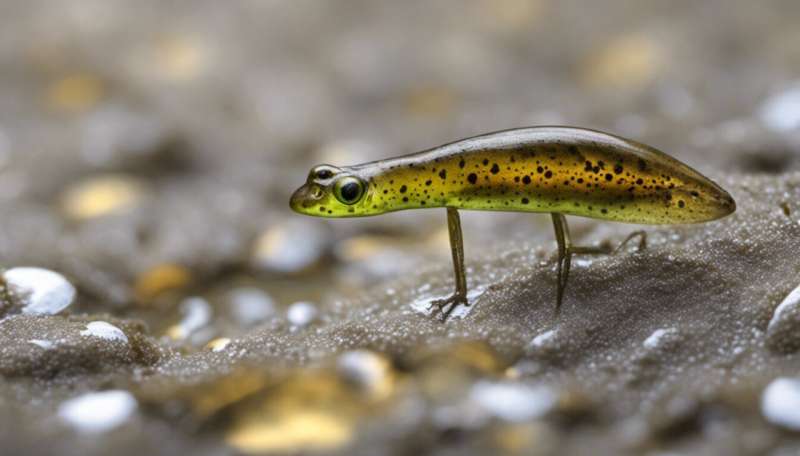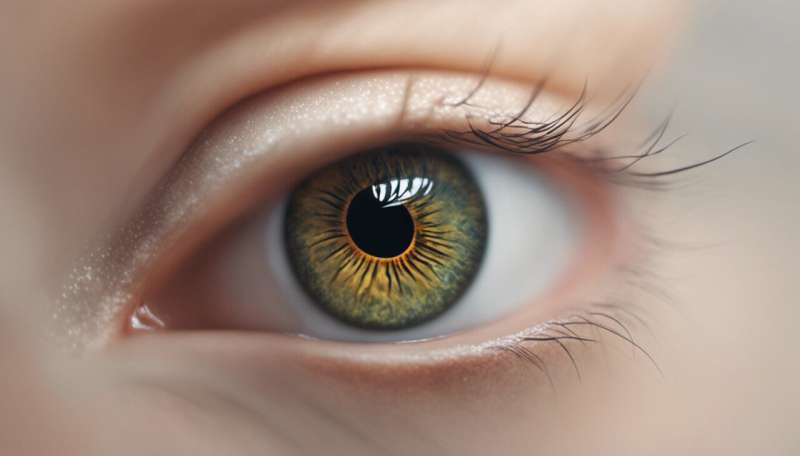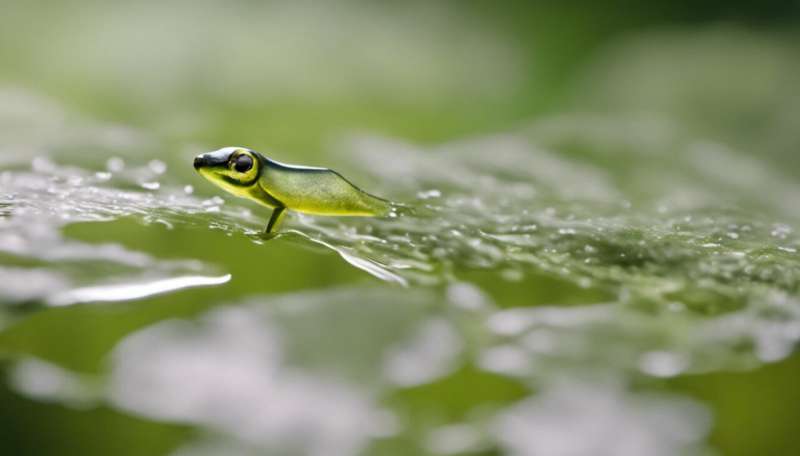Frog lenses can develop differently depending on what environment they will live in as adults

When tadpoles become frogs, their body shape isn't all that changes.
The vast majority of frogs and toads begin their lives as aquatic larvae before they undergo a process known as metamorphosis. Their bodies and behaviors change as their tails give way to legs and they adapt to a life further away from water.
A new study reveals that the changes are even more extensive than previously known. CT scans of more than 100 different species revealed that the lenses of their eyes also changed, depending on what environment they will live in as adults.
Aquatic and burrowing species tended to keep their lens similar to how they were as young aquatic tadpoles, with spherical lenses to focus underwater and for short distances underground. Meanwhile, terrestrial species including climbers, gliders and hoppers tended to flatten out their lenses as adults to give them better vision in air.
Amartya Mitra, a former Ph.D. student at the Museum who led the research, says, "The lens focuses light onto the retina to provide a focused image, but how much refraction is needed depends on the environment an animal lives in. Frogs and toads make important animals to study eye evolution in as they inhabit different environments at different life stages."
"In water the refractive index, which sets the amount light is bent, is pretty much the same as the inside of the eye which means aquatic animals need powerful, spherical lenses to focus the light. On land, the cornea focuses light to some degree and so the lens is flatter and less powerful."
The findings of the study were published in the journal Proceedings of the Royal Society B.
The life cycle of frogs and toads
All frogs and toads are anurans, which is one of the three major groups that makes up the amphibians. Like the vast majority of anurans, they begin their lives as eggs laid by their mother which are externally fertilized by their father.
From this point on, however, the lives of different anurans begin to differ. Some species develop in the egg and emerge as a smaller version of the adult rather than a tadpole.

This process, known as direct development, is generally uncommon. The majority of species will instead hatch as tadpoles, which are typically adapted for life in fresh water with long tails, gills and no limbs.
Past a certain point, tadpoles stop growing bigger, and instead begin to change their shape. Some tissues break down and reform in a process known as metamorphosis which puts them on track to grow into their adult form.
Dr. David Gower, a Merit Researcher at the Museum who co-authored the study, says, "The most obvious parts of metamorphosis see tadpoles lose their tails and gain limbs, but many other changes occur as well."
"The skeleton, for instance, hardens and becomes ossified, undergoing a lot of change in shape to allow them to breathe air and in many cases to move around on land."
"Their diet, meanwhile, changes from mostly herbivorous as a tadpole to a carnivorous one as an adult in almost all cases. It's quite a major transition, especially for those that are transitioning to a more terrestrial life as an adult."
As the rest of the body changes, so do the eyes, with the course of development depending on the environment the adult will live in.
"The lenses are laid down in layers, so a tadpole lens is, in essence, surrounded by additional layers to shape it into an adult lens," David explains. "In species that change the shape of their lens, these changes come about as a result of putting down new layers in a different way to when they were a growing tadpole."
Discovering how these changes take place can provide new information on the evolution of vision not just in frogs, but in vertebrates as a whole.
How do frog lenses change as they develop?
The researchers used 179 frog and toad specimens from 126 species to investigate the shape of their lenses, including 45 species where both tadpoles and adults were studied.

Each specimen was scanned using a microCT scanner, which allowed the researchers to build up a three-dimensional model of what the lenses of each individual looked like. Using scans to study the eyes is a big step forward for this area of science, which previously required destructive sampling of specimens.
Dr. Katie Thomas, a researcher at the Museum and another co-author on the paper, says, "One of the ways lens shape has been studied historically is making a series of really thin slices through the eye and looking at how that two-dimensional shape changes as you go."
"That takes a while to do, so it's not feasible to do that for hundreds of animals very easily. Using CT scanning allowed us to look at a lot more species in a relatively short amount of time."
The study wasn't able to investigate direct developing species, due to a lack of younger specimens, but did find some surprising results among other species. Burrowing frogs, for instance, had much more spherical and powerful lenses than expected which would likely make them short-sighted when on land.
"This was a surprising result, and it may simply result from these frogs not needing to see that far underground," Amartya says. "Being short-sighted may not be that much of a disadvantage for them."
"Alternatively, they may not use their eyes much in the darkness, so the energetically expensive changes to adjust their curved tadpole lenses to flatter adult lenses may simply not be worth it."
"Finally, it could be that they only use their eyes when they emerge for the breeding season, which takes place for a short period of time and mostly in water. In that case, the eyes are well-suited for the tasks they're needed for in the aquatic environment."
Going forward, the researchers, including additional museum co-authors Brett Clark and Dr. Jeff Streicher, hope to be able to investigate more subtle changes in the development of lenses. Their work forms part of an international research project examining the diversity and evolution of vision in frogs and toads.
"We generally have a very broad snapshot of adults versus larvae, and so it would be interesting to look at the changes within different life stages," Katie says. "Some previous studies have shown that the changes in lens shape happen rapidly in some species and more gradually in others, but for most species we just don't know how they take place."
More information: Amartya T. Mitra et al, Ocular lens morphology is influenced by ecology and metamorphosis in frogs and toads, Proceedings of the Royal Society B: Biological Sciences (2022). DOI: 10.1098/rspb.2022.0767
Journal information: Proceedings of the Royal Society B
Provided by Natural History Museum
This story is republished courtesy of Natural History Museum. Read the original story here.




















